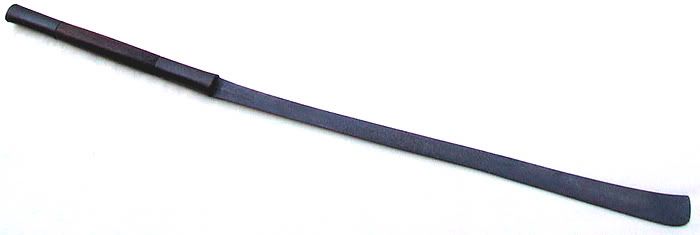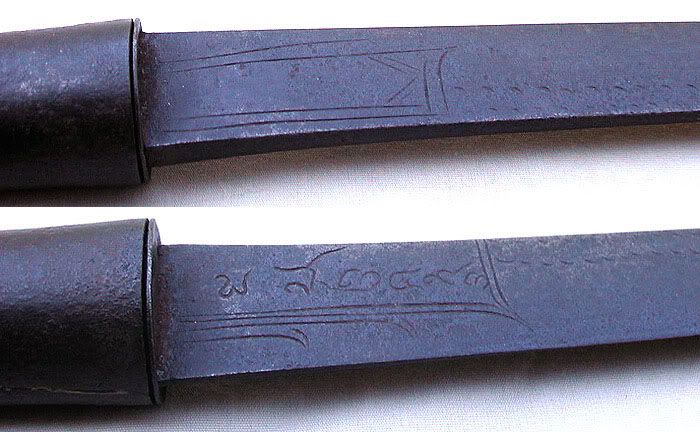
 |
|
|
|
|
#1 |
|
Member
Join Date: Dec 2004
Posts: 987
|
I think those are actually shields. Both a square shield and a round buckler were used at least by the Thai and the Burmese, and I think these guys are supposed to be Siamese troops. These shield look like both, but I am guessing they are supposed to be square shields with a round decoration on them.
The dominant religion in the Khmer Empire up to this period was Vaishnavite Hinduism, but Buddhism was gaining ground. Among the Burmese and Tai (including the Siamese), Buddhism was the religion that replace animism. In terms of material culture, there was an overwhelming Indian influence throughout the region, which in fact are referred to as the "Indianized" cultures of SEA, in distinction to the "Sinocised" culture of most of Vietnam. Armor was little used in continental SEA. When used, it was most commonly just a padded jacket or leather brigandine. Higher-ranked people did wear mail or semi-plate armor in Indian styles. It looks like the cavalry guys in the Angkor relief are wearing either decorated cloth coats, or brigandine. You have the same problem with SEA art as you have with Indian art -- it is overwhelmingly depicting religious themes, and so is both highly stylized and standardized. It is hard to discover historical or regional clues in the art, because the same styles were strongly maintained across time and region. Interestingly, it is mostly in the depiction of the "bad guys," like the army of Mara and these two ceramic raksha that started the thread, that you see more freedom of style and often recognizable ethnic and national dfress and weaponry. One that comes to mind is the inclusion in a Thai fresco of a Dutch soldier with plumed hat, long coat, and musket, among the demonic hordes attempting to stop Gautama's enlightenment. 
|
|
|

|
|
|
#2 |
|
Member
Join Date: Dec 2004
Posts: 987
|
B.I. - Did you take those photos of the tile yourself? In which museum are they?
On re-reading this thread, I realized that the King and temple were Peguan, and not Burmese. It is a distinction that isn't as important now, but historically Pegu in lower Burma had a quite distinct culture, and for many years was a completely separate kingdom from that of Pagan/Ava in the north. The Peguans were/are Mon, related to the Khmer, and not Mramma (Burman, a Tibeto-Burman people). I have been wondering if there is a stylistic and/or developmental distinction between dha of lower Burma - Mon dha - and dha of upper Burma - Mramma (Burman) dha. This tile might be a good clue. |
|
|

|
|
|
#3 |
|
Vikingsword Staff
Join Date: Dec 2004
Location: The Aussie Bush
Posts: 4,524
|
Thanks Mark. I thought there was something "Cambodian" about these swords. The Mon linkage may account for the similarity to Cambodian blades of the same period.
So many small steps on the long march to find the source(s) of dha. Ian. |
|
|

|
|
|
#4 |
|
Member
Join Date: Jan 2005
Posts: 485
|
hi mark,
yes, i did take the images and the pieces are in the victoria and albert museum. i do know the 'india' people there, but have no idea who oversees the tibetan or burmese departments, so i cannot judge the level of expertese. from the accession records, these were aquired in 1966 by the museum. |
|
|

|
|
|
#5 |
|
Member
Join Date: Dec 2004
Posts: 987
|
1966? Interesting. I wonder how much of the original temple is still there? Another item on my list of things to go see if I ever can get to Myanmar.
 The V&A (and Leeds) are definitely places I need to visit, and their curators are people to whom I need to ingratiate myself.  Thanks for the further info. |
|
|

|
|
|
#6 | |
|
Member
Join Date: Jan 2006
Posts: 123
|
Quote:
|
|
|
|

|
|
|
#7 |
|
Vikingsword Staff
Join Date: Dec 2004
Location: The Aussie Bush
Posts: 4,524
|
Compare the pictures here of what I think is a Thai darb (perhaps PUFF might confirm the blade inscription as Thai) with the rear horsemen's swords in the picture of the bas relief above that Mark B. posted.
This sword is interesting in that it is quite long, consistent with many cavalry swords, widens a little towards the tip, and the tip turns up slightly on what is otherwise a fairly straight blade. The hilt is a three-part construction and of oval rather than circular cross section. A sturdy iron ferrule adorns each end of the wooden handle, and there are iron plates covering the ends of the hilt, each secured by two nails. There are engravings on the blade, with an inscription at forte that may be a person's name (help needed with translation please). Based on the swords shown in the bas relief, this style seems to be quite old, perhaps dating to the 13th C or earlier. Overall length = 88 cm Length of blade = 58 cm Length of hilt = 30 cm Ian.      Last edited by Ian; 23rd July 2006 at 02:07 AM. |
|
|

|
|
|
#8 |
|
Member
Join Date: Jan 2006
Posts: 123
|
I reconize the writing on the sword. It would appear the first two inscriptions are Thai alphabets, and the latters are Thai numerical symbols. Thai and Camobodian use the same numerical symbols if I'm not mistaken. The first alphabet looks like a W and the second one looks like an "h" that written backward with a tail on top. I'm not sure if this has any influence from the Romans, but I don't think so since Thai alphabets is based on Khmer and Mon alphabets, which in turn is influenced by Sankrit from India, I believe. Fascinating!
|
|
|

|
|
|
#9 |
|
Member
Join Date: Feb 2006
Location: 30 miles north of Bangkok, 20 miles south of Ayuthaya, Thailand
Posts: 224
|
The blade shape might be old in design, But the inscription 's BE 2493 (Buddhist Era), which is AD 1950.
http://www.omniglot.com/writing/thai.htm (translation for Thai alphabets and numbers) พ.ศ. or พ.ส. 's translated to BE (please enable Thai encoding in your page) The final hint 's two masonary nails on the butt cap. The round head nail with hatch "#" on it 's considered modern, which 's consistant with the inscription. |
|
|

|
|
|
#10 | |
|
Vikingsword Staff
Join Date: Dec 2004
Location: The Aussie Bush
Posts: 4,524
|
Thanks PUFF.
I'm not surprised that this one dates from the mid 20th C. Although heavily patinated on the blade and ferrules, it does not look especially old. Like you, I had noticed the recent nails in the hilt and thought that the handle may have been a recent replacment on an older blade. But it appears that the blade too is quite modern, although shows signs of use and sharpening. A couple of questions for you. Have you seen this style of blade in older swords? If this form has been around for a long time, I would expect that it may be quite common, and yet I have not seen other examples. And why do you think this one has a date when very few Thai swords have dates or incriptions? Why would someone take the time to do that on what appears to be rather a plain and utilitarian sword? And lastly, where do you think this one was made within Thailand? Do the markings provide any clue? Ian. Quote:
|
|
|
|

|
 |
|
|